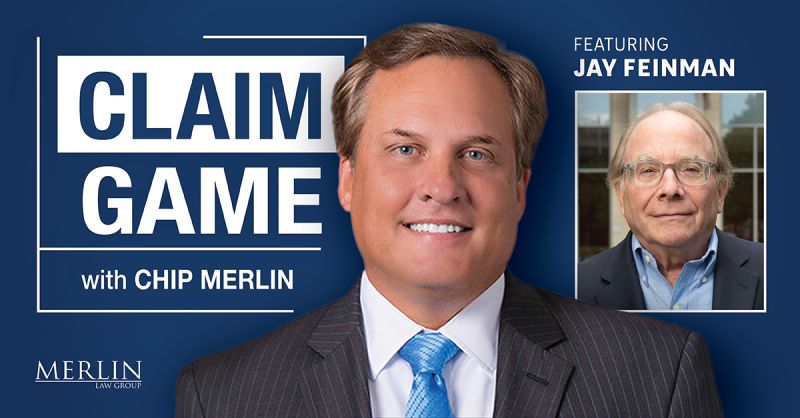In my recent Claim Game interview with Professor Jay Feinman, one moment in particular captured what many in the insurance world know, but rarely say out loud: insurers get away with bad faith because courts or court-made law let them. That might sound like an exaggeration or sour grapes, but as Feinman and decades of legal scholarship have made clear, the structure of our judicial system has evolved in a way that excuses systemic claims abuse. This is often at the direct expense of policyholders who have already suffered a loss.
Feinman, a Distinguished Professor of Law at Rutgers and author of Delay, Deny, Defend, emphasized how the legal system increasingly grants insurers broad latitude under the guise of variation of the term “reasonableness.” Courts routinely hold that an insurer cannot be found liable for bad faith as long as its decision to deny or delay a claim was arguably reasonable, even if that decision was ultimately wrong. As Feinman explained, this doctrine has created an enormous burden for policyholders. To prevail in most states, the insured must prove that the insurer’s conduct was not just wrong, but also unreasonable, and often intentionally so. It is a standard that turns what should be a safeguard into a near-impossible barrier.
This shift in the legal landscape has been documented in numerous scholarly articles. One of the most cited is “Good Faith as a Matter of Law: The Insurance Company’s Right to Be Wrong,” 1 which analyzes how courts have transformed the concept of good faith into a right to make reasonable wrong decisions and actions. In practice, this has gutted the policyholder’s ability to challenge unjust denials. As long as an insurer can present any plausible argument for its position, many courts will dismiss the case outright before it ever reaches a jury.
Further reinforcing Feinman’s concerns is the judicial tendency to treat reasonableness as a matter of law, rather than a question of fact for a jury. A 2018 article, Negligent Bad Faith? Limiting Insurance Bad Faith to Its Roots, 2 noted that courts are increasingly deciding bad faith cases at the summary judgment stage, effectively taking them out of the hands of juries. The article stated that the “reasonableness” standard by which others are held liable is not the same for insurance companies. This means that even when a policyholder has suffered a clear and devastating loss caused by an insurer that has not acted reasonably, they may be denied their day in court if the insurer can frame its decision as “legally arguable.”
The consequences of this judicial protection go beyond legal technicalities. Empirical research shows that when states adopt meaningful bad faith statutes and allow those claims to proceed to trial, insurer behavior changes. A study of first-party auto claims found that in states with strong bad faith laws, insurers paid claims more promptly and fairly, even to policyholders who lacked legal representation. The mere existence of real consequences had a measurable effect on claims practices.
This stands in contrast to states where bad faith is nothing more than a paper tiger. In New Jersey, for example, Feinman noted that despite having a bad faith doctrine in place, only a handful of plaintiff verdicts have occurred in decades. The bar is simply too high.
The message to policyholders is clear: Unless you can prove malicious intent or systemic misconduct with documentary precision, you can expect to have no recourse. The insurer can delay, deny, and defend. At worst, it might have to pay what it should have paid in the first place. There is no penalty for breaking the rules if the only consequence is playing catch-up.
Even more troubling is the arsenal of legal defenses available to insurers. Courts have upheld doctrines like the “advice of counsel” defense, which allows insurers to escape bad faith liability if they can show that their lawyer advised them to deny a claim. Other procedural maneuvers, like denying that any valid “demand” was made or insisting that no duty to settle existed, prevent courts from ever reaching the substance of the case. These legal strategies may be valid in narrow circumstances, but they are often used to deflect accountability and prevent systemic scrutiny.
Feinman allowed me to compare this system to a bank robbery where the thief is merely forced to return the stolen money with no punishment, no fine, and no deterrent. Imagine a world in which robbing a bank carried no consequence so long as you eventually gave the money back. That is the reality for policyholders in many jurisdictions today. When insurers breach the duty of good faith, the worst-case scenario is simply paying what was owed all along and after a long and expensive legal fight that drains the policyholder of time, money, and emotional energy.
The solution, as Feinman argues, is not to eliminate discretion from claims handling but to hold insurers to a standard of what a reasonable insurer would do in their systems and decisions. If the claims process produces unjust outcomes, the insurer should be liable not because it was evil, but because it was not reasonable. That is the same standard we apply in virtually every other area of civil liability, from auto accidents to product safety. There is no reason insurers should be held to a lower bar.
Jay Feinman’s warning should not be ignored. It reflects not just a scholarly opinion but a systemic reality experienced by thousands of consumers and lawyers. If we want a claims system that works for everyone, we have to look beyond the behavior of individual insurers and confront the judicial doctrines that allow injustice to flourish. The law should protect the people who pay for protection and not the companies that profit from avoiding it.
Here is the link to the interview.
Thought For The Day
“For critics of the industry, the McKinsey documents are the smoking gun that describes in detail how the claims process shifted from customer service to profit center.”
—Jay M. Feinman, Delay, Deny, Defend
1 Douglas g. Houser. Good Faith as a Matter of Law: The Insurance Company’s Right to Be Wrong. 27 Tort & Ins. L.J. 665 (Spring, 1992).
2 Amanda Proctor, Christopher Freeman. Negligent Bad Faith? Limiting Insurance Bad Faith to Its Roots. Georgia Defense Lawyers Association Law Journal (2018).





